1,695 views
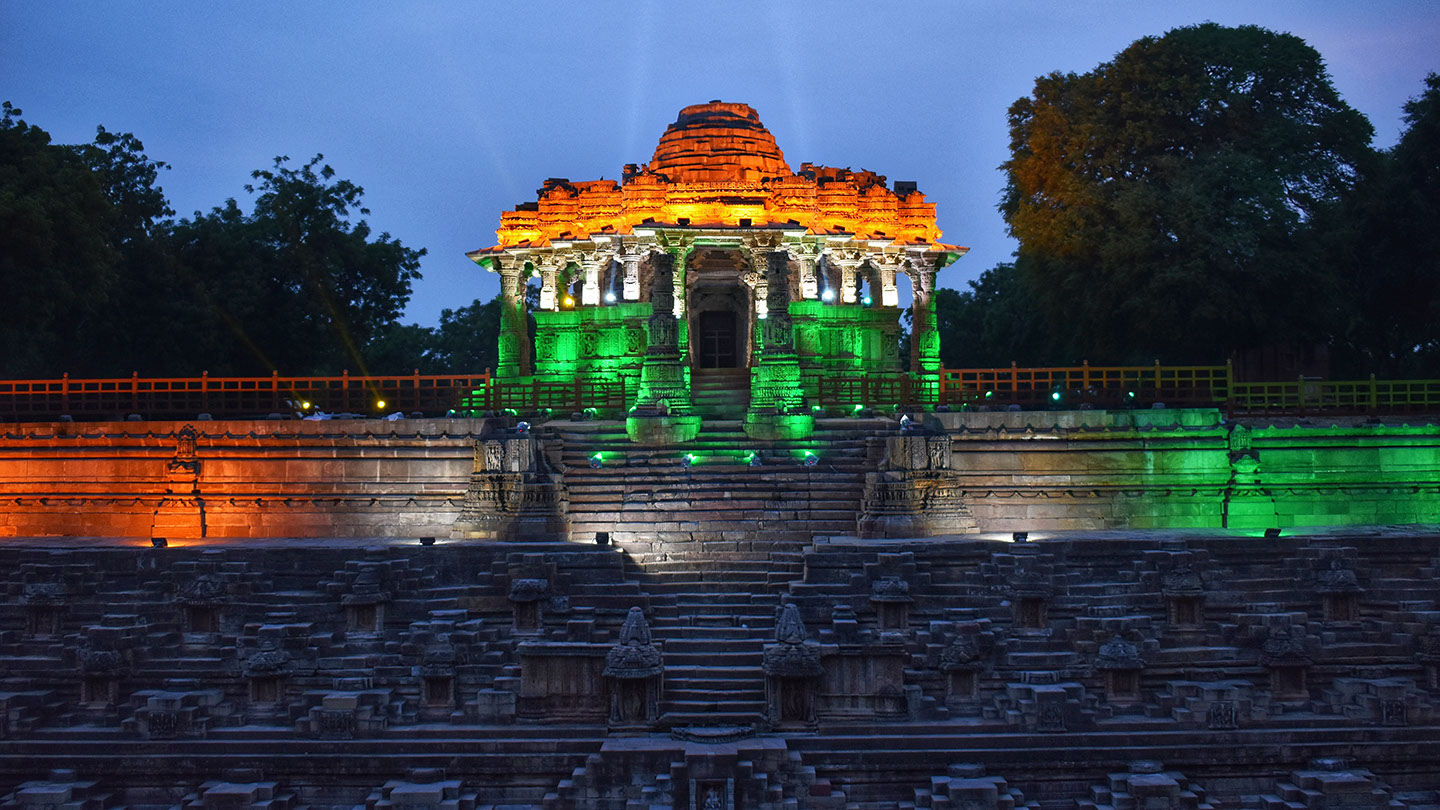
Carved Legacies: The Sun Temple in Modhera
By Rahuldev Rajguru
Last Updated: 16 Oct 2022
What do Stonehenge in the UK, Mayan Pyramids in Mexico, the Modhera Sun Temple and a spacecraft a million miles away, have in common? They are linked by a strong human urge to uncover the mysteries of the Sun, Moon, Planets and Stars. Sun worship has been practiced in Hindu and many other religions across the world since ancient times. In the Hindu scriptures, the sun is often referred to as the powerhouse, attributing names like Surya or Aditya to the Sun God. Particularly, In India worshiping of the Sun dates back to many centuries ago. This is indicative by the number of deities that have been worshiped which show some connection with the sun in some way or other. For example, Lord Vishnu, the preserver is said to be born under the sun, while his consort Lakshmi, goddess of wealth and prosperity, is said to be born under the moon. Even Lord Shiva, who is usually associated with the elements of fire and water, has a special affinity for the sun.
There are sun temples throughout India as manifestations of these centuries-old practices of worshiping the Sun god. Modhera, Gujarat is home to one of the trinity of famous Indian sun temples. My first visit to Modhera Sun Temple 25 years ago was tainted with unbearable weather and the negligence of the monument was disheartening. The place was unmanned with garbage strewn everywhere and it seemed to have turned into a temporary shelter for stray dogs and cattle. This initial experience certainly lowered my expectations this year in 2022 when I finally dared to visit again. I was in fact gobsmacked the moment I set my eyes on the historical site. The Archaeological Survey of India (ASI) and the Gujarat Government have transformed this mesmerizing heritage site into an international tourist destination. The transformation is indeed stunning and praiseworthy. In 2014, UNESCO included Modhera Sun Temple in a tentative list of World Heritage Site.
Modhera is about 100 km from Ahmedabad, which is also the city's nearest airport. The best way to reach Modhera from Ahmedabad is by public transportation or by joining a private guided tour of the Sun Temple. I recommend that you set aside at least 3 hours for your visit.
Accommodation options in Modhera are limited, since it is a small village. A new ecotourism resort with luxury tents and cottages has recently opened just a few hundred meters away from the temple. There is also the option of staying in a hotel near Becharaji or Mehsana, which are about 12-25 km away.
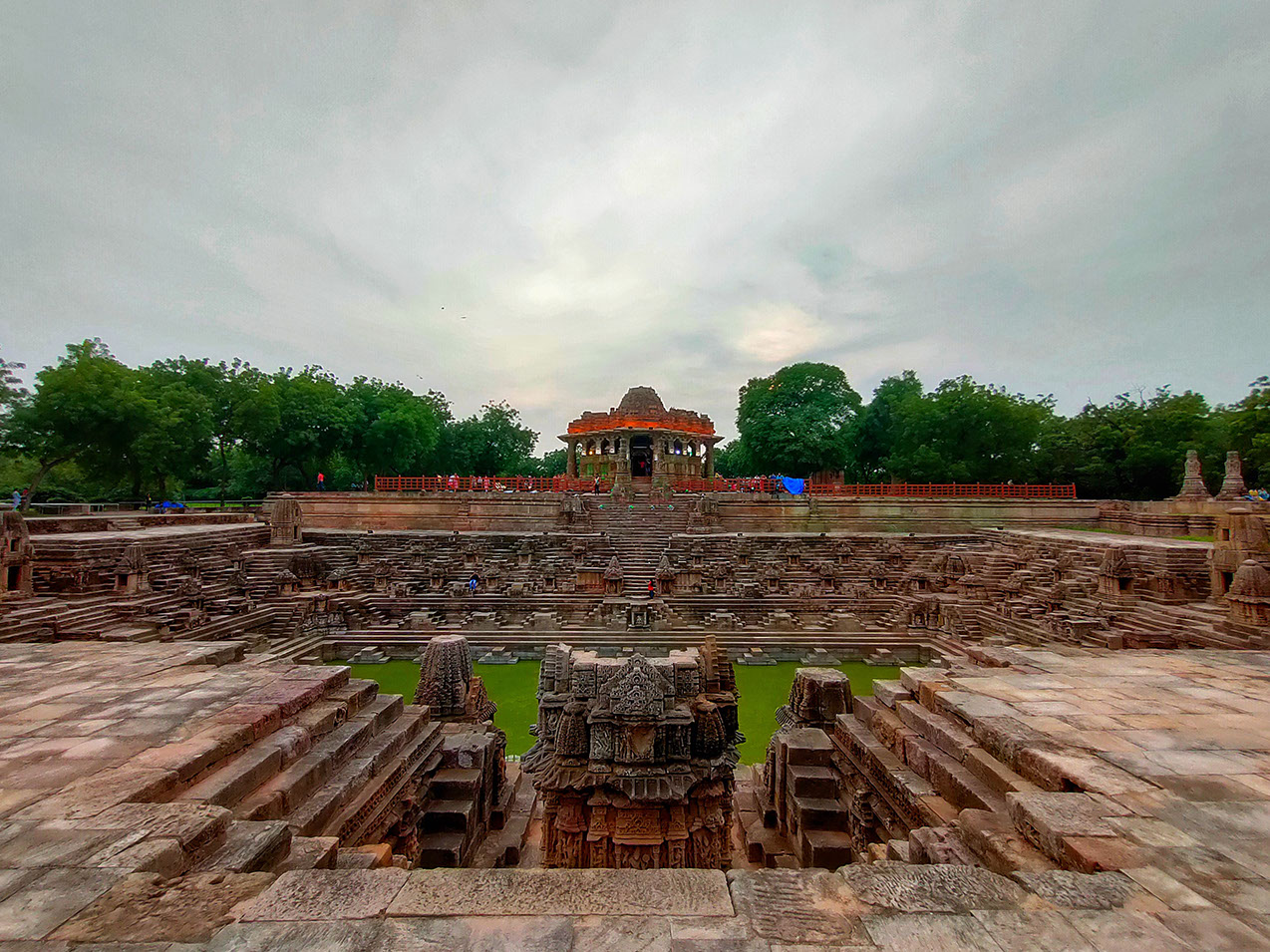
The stunning panorama of an ancient sun temple in India that dates back 1000 years
I was greeted by the reflection of the Sun Temple in the pond after a short walk from the parking area. The visual splendor and the natural beauty of the site is like a beautiful lady in red and you can't help but stop to stare. The temple's grandeur is simply stunning and it proudly emulates the legacy which it holds. The experience for me was poignant and overwhelming at the same time. The silent water from the pond, the occasional ripples from playful turtles created a beautiful ambience for reflection and awe. I could have been lulled into historical stupor, if not for the happy birds closeby!

In 1024, King Bhimadev Solanki I of the Chalukya dynasty built the Modhera Sun Temple. Not many people know that the Chaulukyas were suryavanshis, descendants of the Sun God. Therefore, the temple is dedicated to Surya, the Sun God. The entire complex was built from coarse-grained, buff sandstone in red-brown color. The dry masonry method was adopted to set the stone block in layers without joining them with mortar. The stability was achieved by carefully balancing the weight of stones. The thought and effort reflects in the solidarity of the construction.
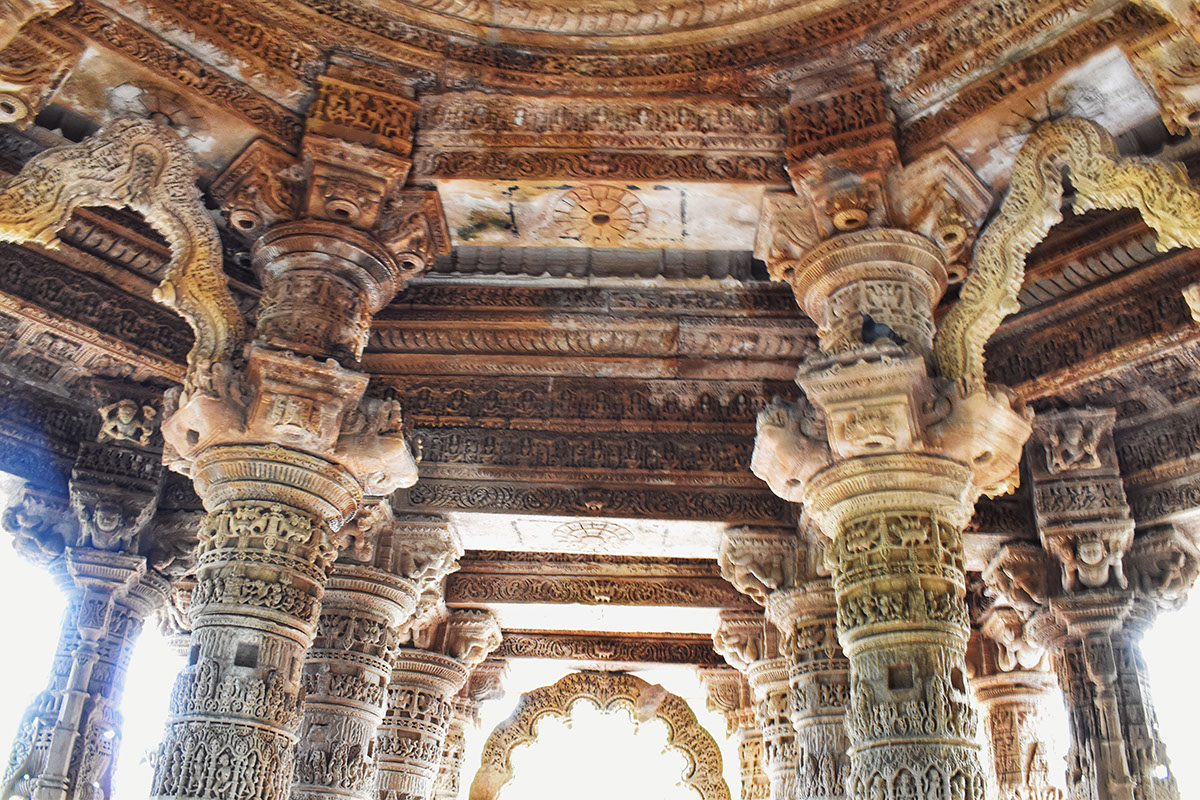
Stunning torans, pillars, and carvings of Modhera Surya Mandir
Interesting Trivia
The Sun Temple of Modhera was intently designed so that on the day of the Solar Equinox, the first ray of the sun caresses the sanctum where the gold idol of the Sun God was astutely placed. A diamond on the crown of the idol would reflect the sun's rays, illuminating the entire temple. The Sun appears directly above the Equator during the Solar Equinox, making day and night equal in length. The Earth experiences two solar equinoxes annually, the Spring Equinox (March 21) and the Autumn Equinox (September 23).
Another astutely planned design aspect of the sun temple can be observed on the day of June Solstice, which is usually June 21. The rays of the sun drape the top of the temple without casting a shadow. The temple is located near the Tropic of Cancer at a latitude of 23.5835 N and 72.1330 E. The northern hemisphere tilts towards the sun at its maximum extent during June Solstice. Tropic of Cancer being the most northerly circle of latitude on earth can have the sun directly overhead on this day.
Interpretation Center and Museum
With great anticipation I began my Modhera tour by visiting the Interpretation Center and Museum next to the parking area. I'm a hodophile. I love to travel and this passion leads me to delve a bit deeper into history and architecture whenever I visit a heritage site. I had hired a guide for Rani ni Vav in Patan. I was disappointed by his lack of enthusiasm in answering my questions as he was preoccupied with other customers to serve. Consequently, I decided not to hire an onsite guide in Modhera city. The museum has pictures, maps and sketches of the entire complex, which is all I needed for my latest quest. I got lucky when I met a gentleman there who was kind enough to guide me through the entire exhibit. He was quite knowledgeable and could explain the whole history behind the temple and patiently answered all my questions in detail. It's a huge property, with his guidance, I learned where to begin the journey and how to navigate my way around. This was a big advantage as most tourists make the mistake of beginning their tour either with the sanctum or the kund without having a proper understanding of the temple's architecture. Being able to speak a local language can sometimes hand you an unexpected trump card.
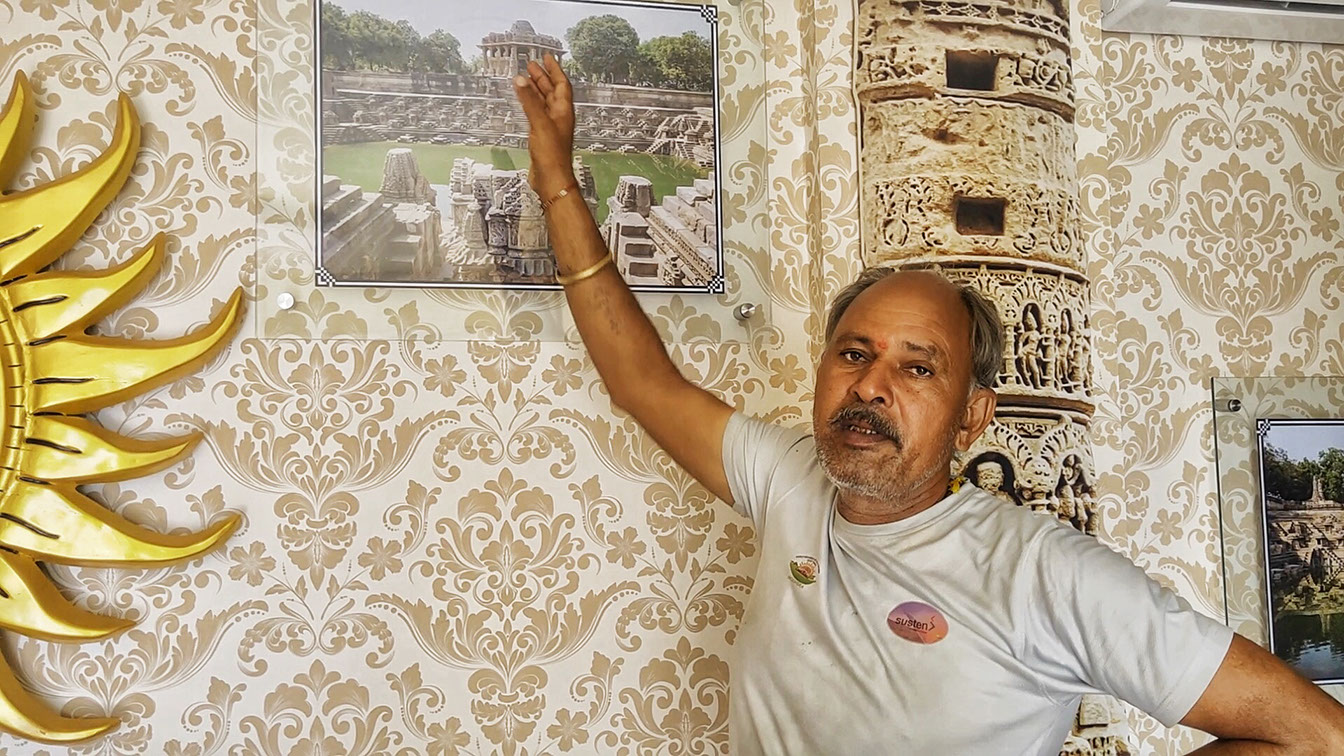
The guide at Modhera Museum and Interpretation Center
The temple complex consists of three main sections.
(1) The Holy Kund (Surya Kund)
(2) The Nritya Mandapa (or Sabha Mandapa)
(3) The Mula Prasada (Main Temple)
Making use of my earlier trump card, I bypassed all these sections and immediately reached the north-east corner (right side of the Kund). There's a platform with big stone slabs surrounded by stairways. It has two broken Torans (pillar shafts) with the same sequence of beautiful moldings as the temple's core. It consists of two lone pillars that hold no structure. It is one of the main entrances to the temple complex, which was destroyed during the invasion. The south-east corner (left side of the Kund) is also believed to have one such entrance.
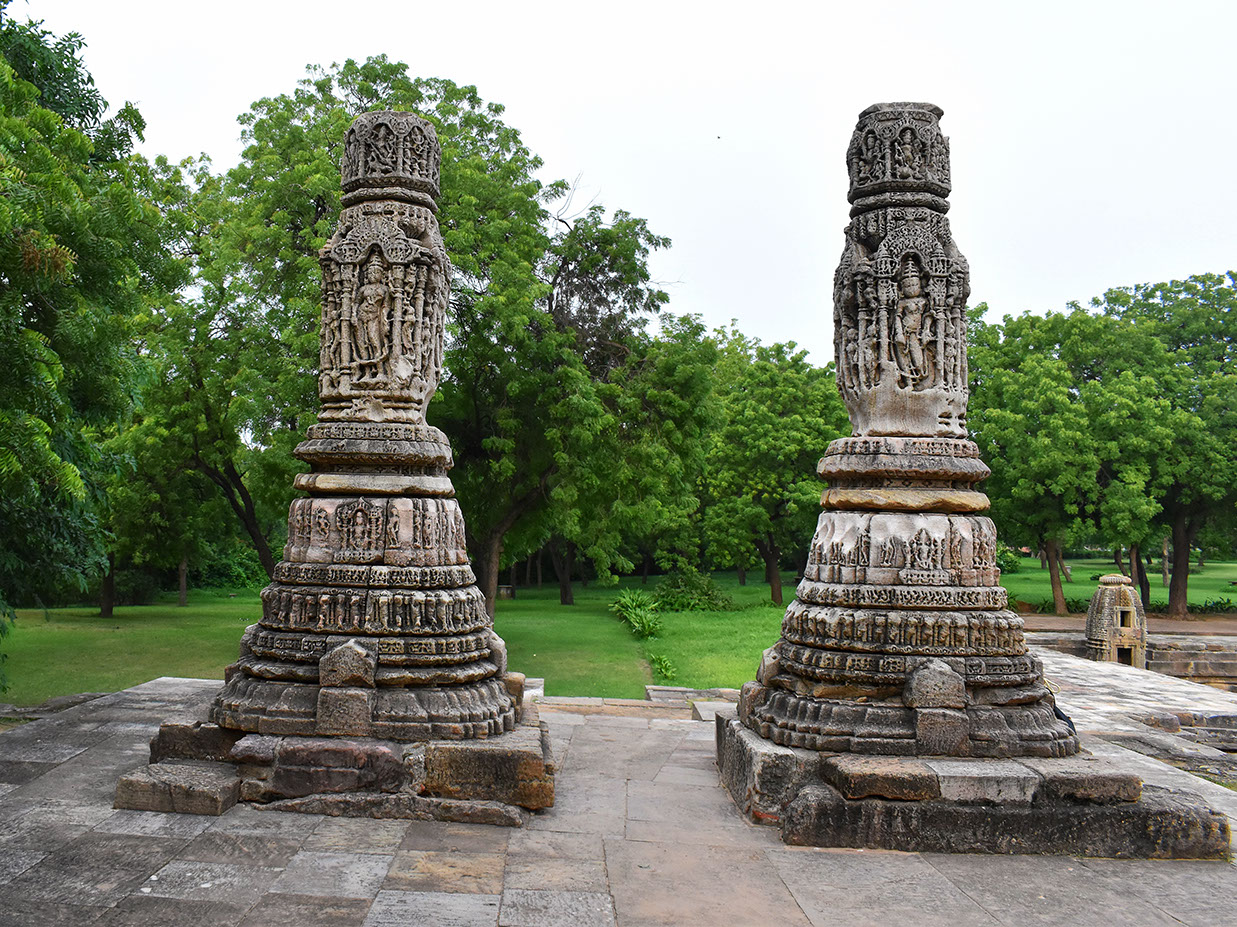
These two pillars are remnants of Modhera Sun Temple's northeast entrance
The Holy Kund (Surya Kund)
In the olden days, travel took a longer time. Tourists often were tired when they reached their destinations. Therefore, on reaching Modhera, they would enter through the entrance and head straight for the Surya Kund filled with water, where they could take a bath and relax. Back then, it was a mandatory custom to enter the temple only after taking a bath (the process of purifying one's body and mind). Surya Kund served as the entrance to the temple.
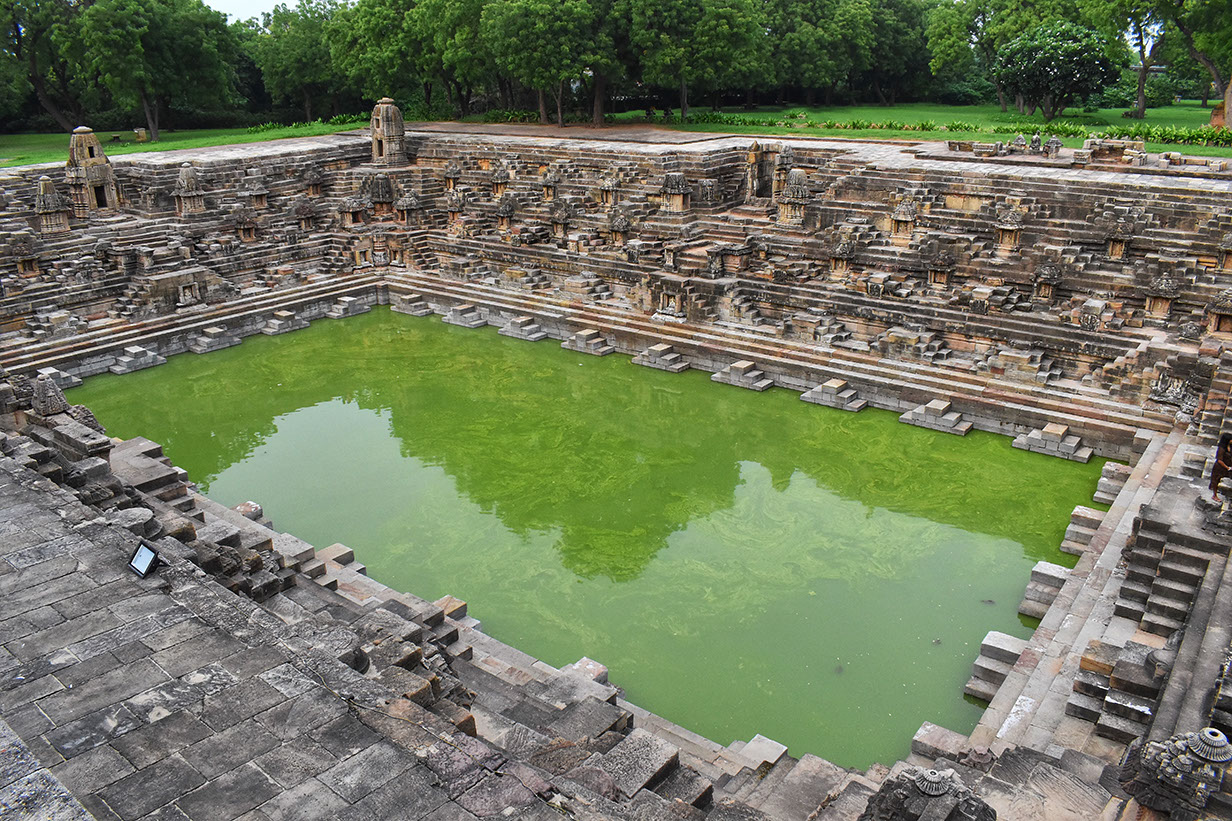
Surya Kund was the first structure built at Modhera Sun Temple
Surya Kund, sometimes called Ram Kund, is a rectangular tank fed by groundwater. The tank is measured at 123 feet from north to south and 70 feet from east to west, and is surrounded by a flight of four terraces that rise 15 feet between the ground level (176 feet x 120 feet) and the tank. Staggered rows of small pyramidal stairways connect the terraces. There are square or rectangular steps on the stairways except for the first step of each flight, which is semicircular.
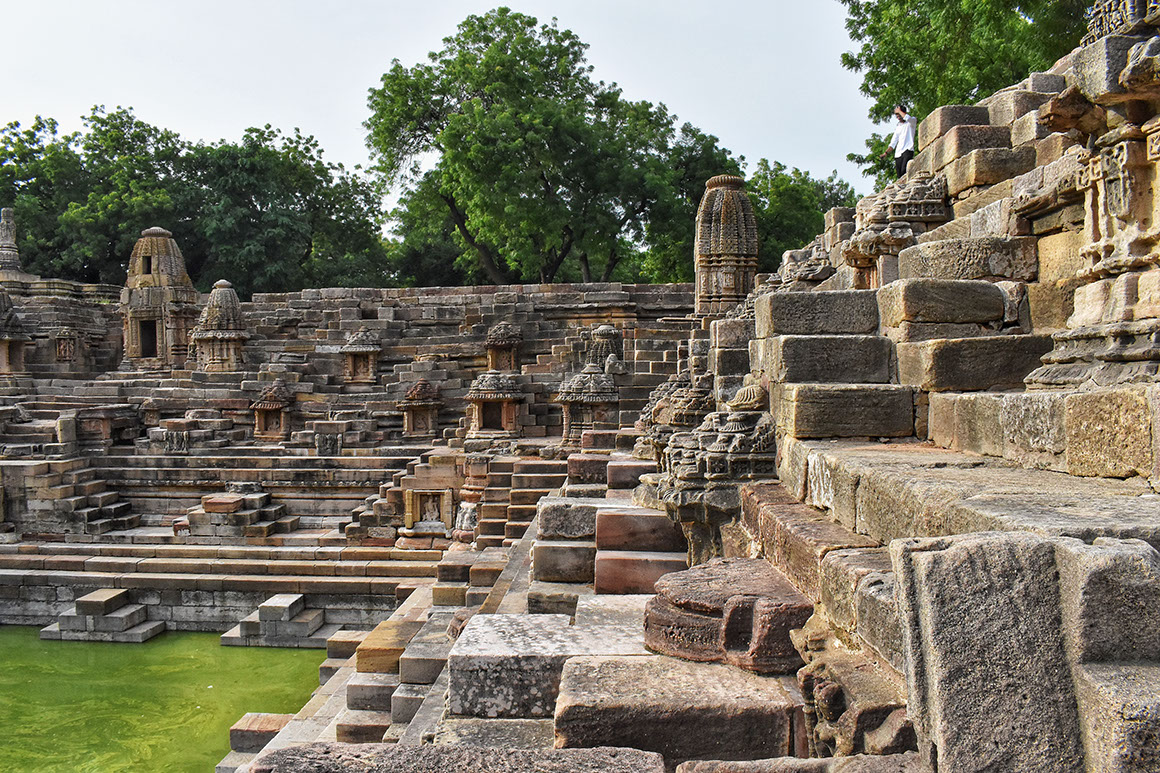
Surya Kund is surrounded by terraces and shrines connected by pyramidal stairways
Between the stairways of the middle terraces are 108 shrines (small temples) with bell-shaped roofs. Why 108? What's so special about this number? Keeping in mind that this is a Sun Temple, the design was based on the solar system. In Hindu mythology, the sun is known by twelve names. A Hindu calendar has 12 lunar months as well as 12 zodiac signs. In our solar system, there are 9 planets, including the star. So, 12 x 9 = 108. The diameter of the Sun is 108 times that of the Earth. The distance between the Sun and the Earth is approximately 108 times the Sun's diameter. As a result, people who worship the Sun God perform 108 Sun salutations (Suryanamaskars) on solstices and equinoxes.
These 108 temples are dedicated to Hindu deities with some of their reliefs inside, but the rest are broken. Many of these reliefs have become unrecognizable due to climatic influences. The four prominent temples around the Surya Kund are those of Lord Vishu, Ganesha, Shiva, and Goddess Shitalamata.
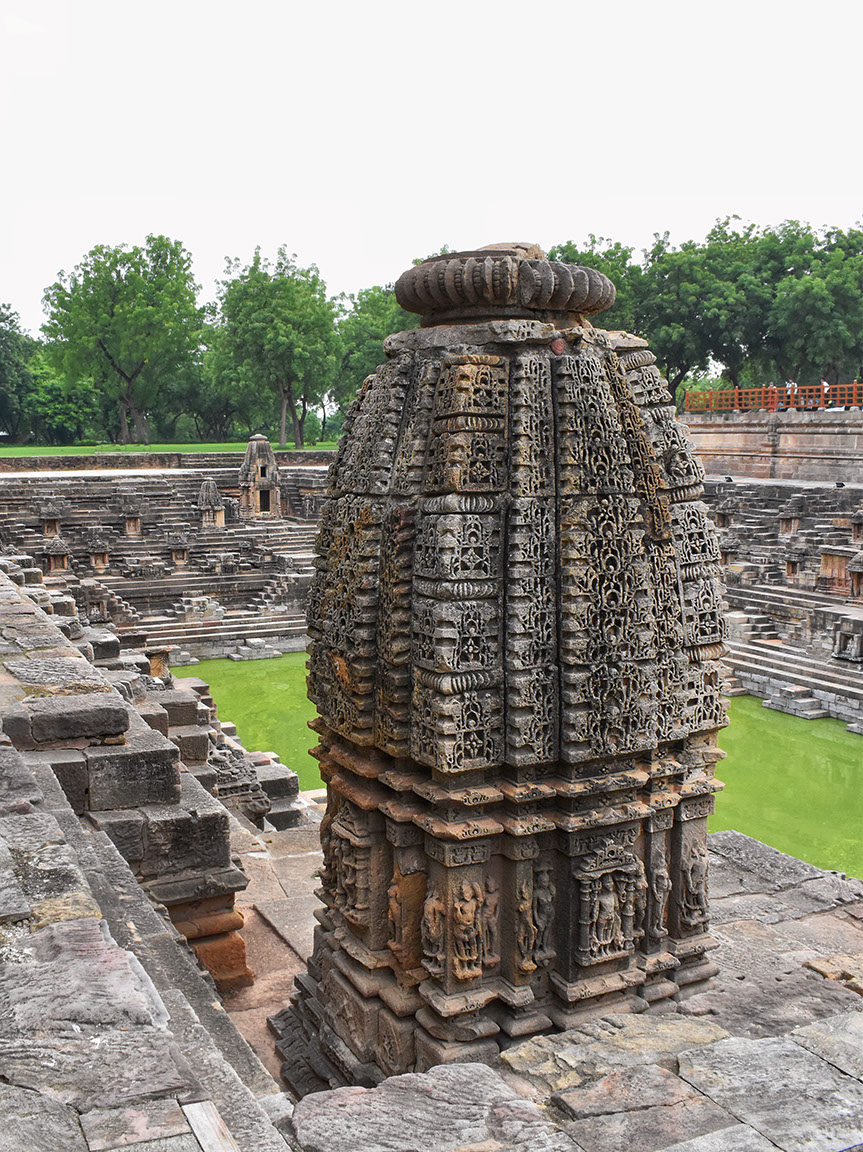
One of the exquisitely carved temples surrounding Surya Kund
Sabha Mandapa
The Sabha Mandapa, also known as the Nritya Mandapa, was accessed through ornately decorated Kriti Stambhs (pillars). The Kirti Toran (arch) built over the pillars has collapsed, leaving only free standing pillars.
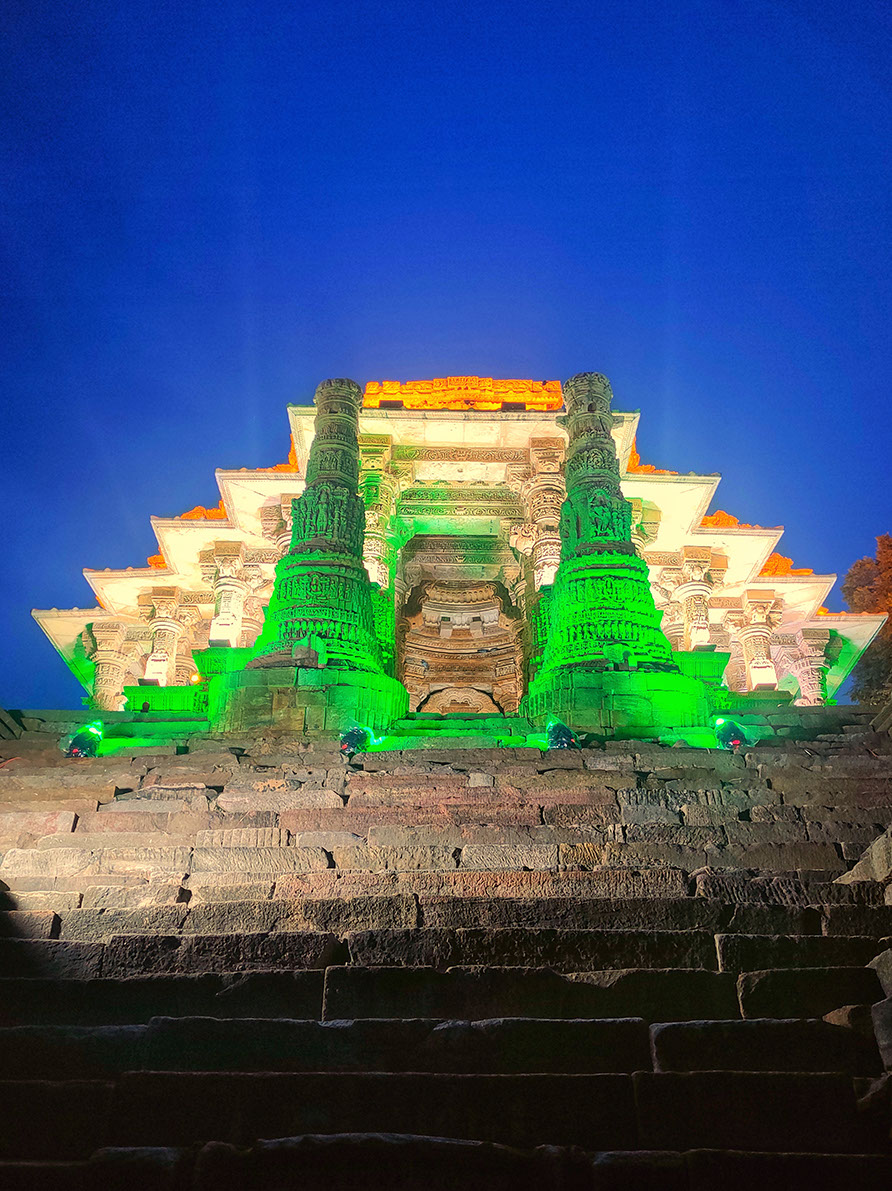
A beautiful Kirti Toran lit up at night
The Sabha Mandapa or "Meeting Hall" was the place where the King held meetings and dance festivals. Archeologists believe this hall was built last after the Kund and the main temple was built. There are 52 intricately carved pillars supporting this octagonal structure. A solar calendar has 52 weeks. The carvings depict various episodes from the Ramayana and Mahabharata. The hall currently has four entrances, one facing each cardinal direction. Based on the ground plan of the side elevation presented by British archeologists James Burgess and Henry Cousens, the interior of the hall was accessed only from the east and west sides. The details are mentioned in the book titled The Sun-Temple at MODHERA: A Monograph on Architecture and Iconography by Wibke Lobo.
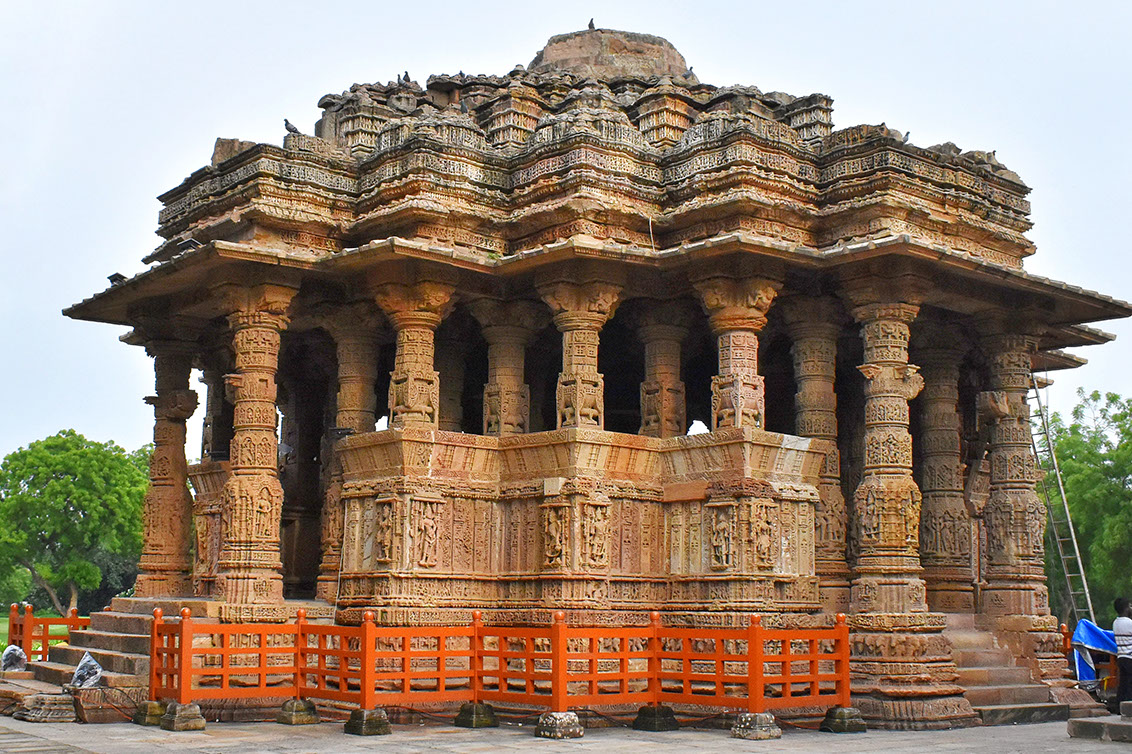
The Rang Mandapa, also known as Sabha Mandapa or Nritya Mandapa, was the last structure to be built at Modhera Sun Temple
The entire Sabha Mandapa is placed on an elevated platform (plinth). The profile of the exterior wall of this hall is divided into following sections.
- (1) The Socle (Pitha): It displays a similar sequence of horizontally running decorative elements.
- (2) A connecting figural frieze (Rajasenaka): It runs all around the socle at the height of the inner floor and slightly canopied by a projecting cornice. It illustrates dancing and musical narratives.
- (3) Balustrade (Vedika): These narrow beams are alternately recessed and decorated with the figures of different deities.
- (4) Rectangular pillars (Purnaghata): They do not directly rise up above the coping stone as it is seen from the outside. In fact, they rise from the base of the inner floor of the hall.
- (5) The superstructure: They form the base of the roof. They look like a canopy that is slightly tilted downwards.
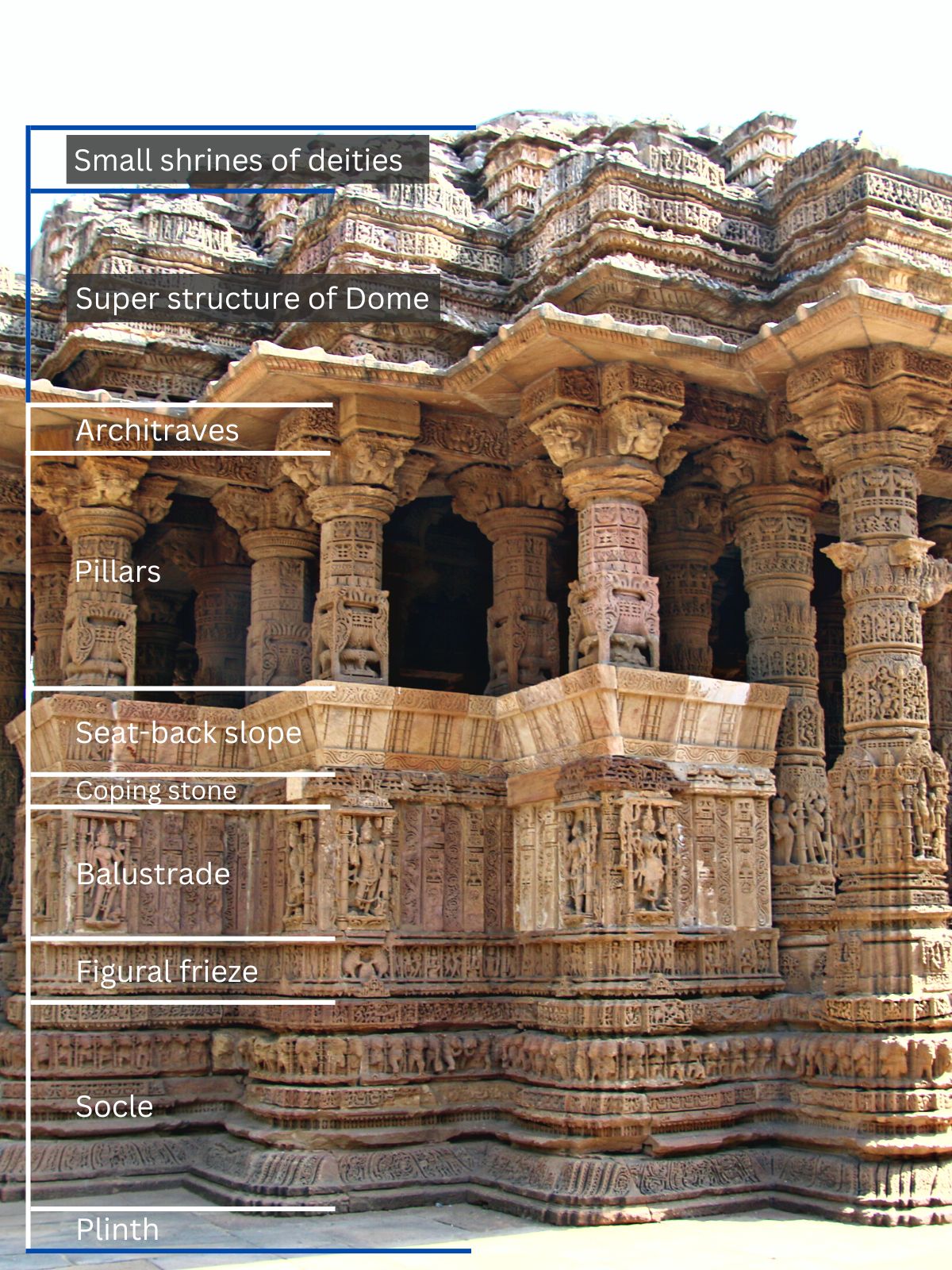
Architectural profile of the exterior wall of Sabha Mandapa or Dancing Hall
Two parallel rows each containing four pairs of pillars from the entrance lead toward the center of the hall, forming an octagon that supports the central dome. Thus, there are a total of 8x4 = 32 pillars at the entrance porches that have a square terraced base. There are five pillars on each of the remaining four sides of the octagonal structure, for a total of 20 pillars. According to the previous image, these pillars with an octagonal terraced base follow the recesses and projections of the outer wall.
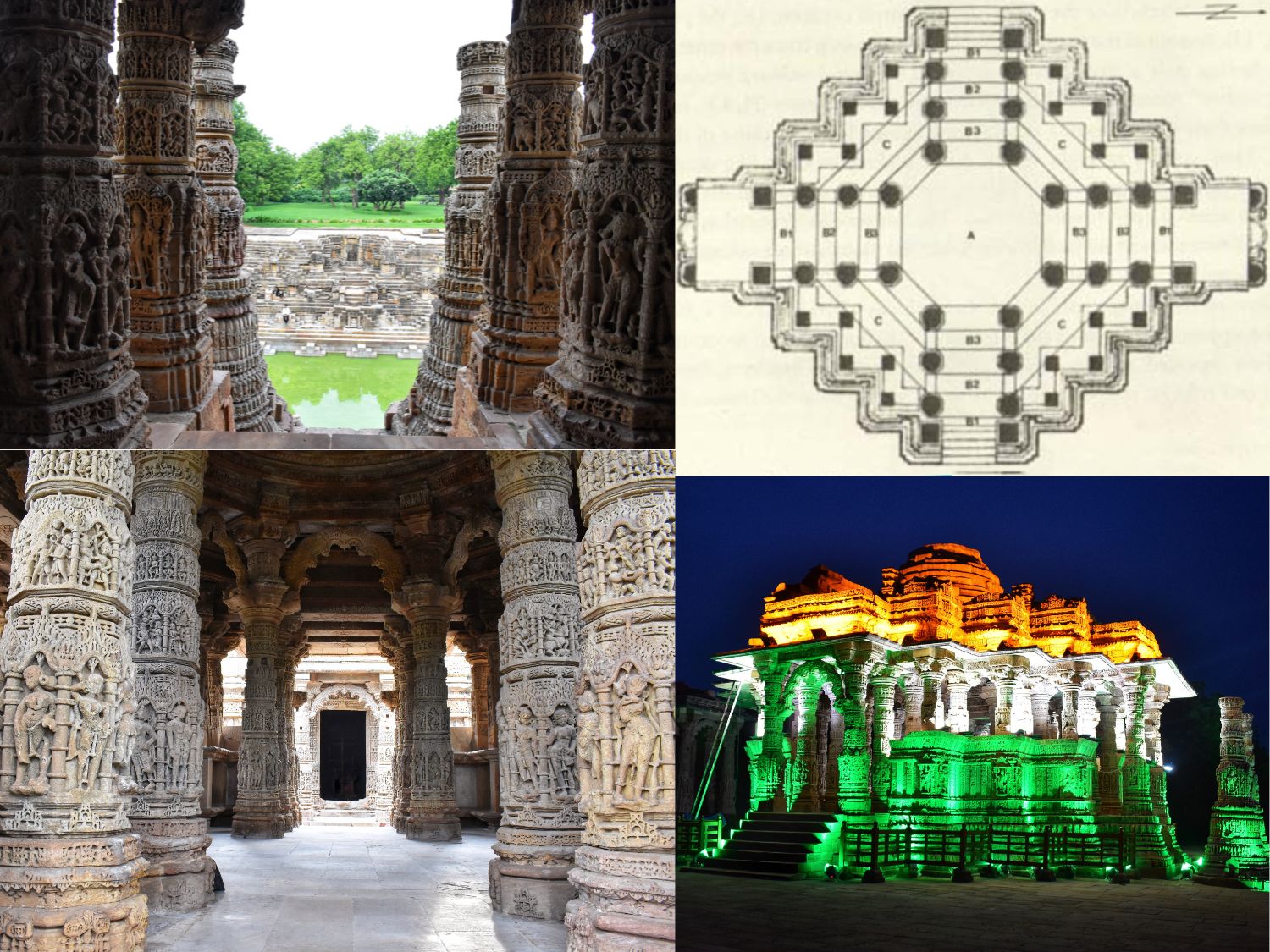
An interior and exterior view of the Sabha Mandapa's east entrance (Left)
The ground plan and landscape view of the Sabha Mandapa (Right)
There is an incredible variety of illustration on both sets of pillars that represent various chapters from the Ramayana, Mahabharata, and other Hindu mythologies. Several of these pillars were designed according to Vastu Shastra theory. Some of the noted carvings and decorations are:
- Seated deities in all the pillars
- Apsaras (dancers) in different poses
- Everyday life scenes
- Scenes of Sitaharan from Ramayana
- Ganesh eating laddoos
- Bhairava drinking blood from kapala
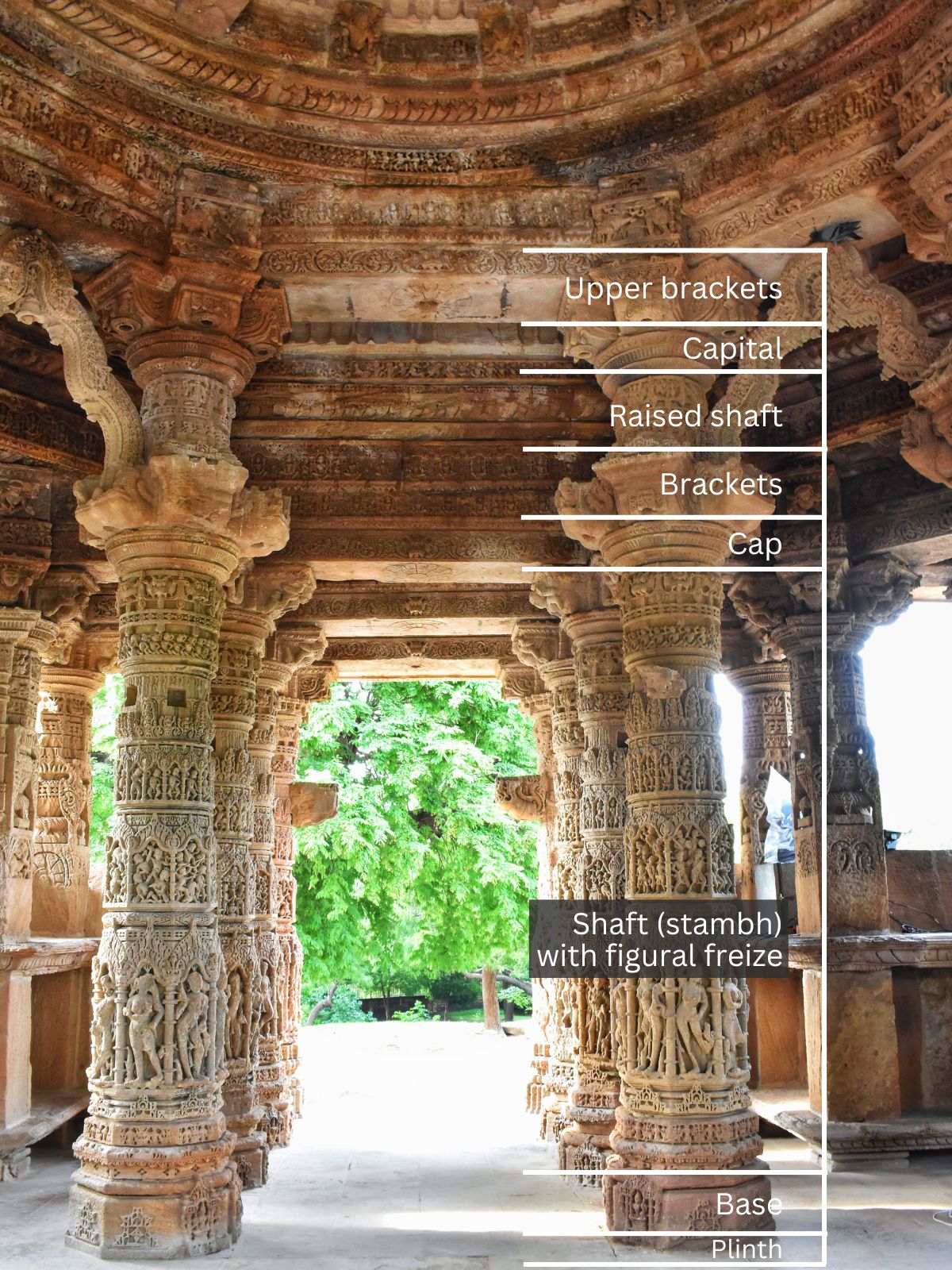
Architectural profile of the pillars supporting the central dome in Sabha Mandapa
There are three types of ceilings in the Sabha Mandapa. Between the four pillars and the entrance porch, there is one. Another type is the diagonal ceiling at the four corners between the cardinal points. It is flat and starts directly above the architrave. However, the central corbelled dome above the inner octagon is the most striking. There are sequences of decorations in the multi-tier rings in the form of figural frieze. Most of them are based on the famous battle between humans and demons in the Ramayana.
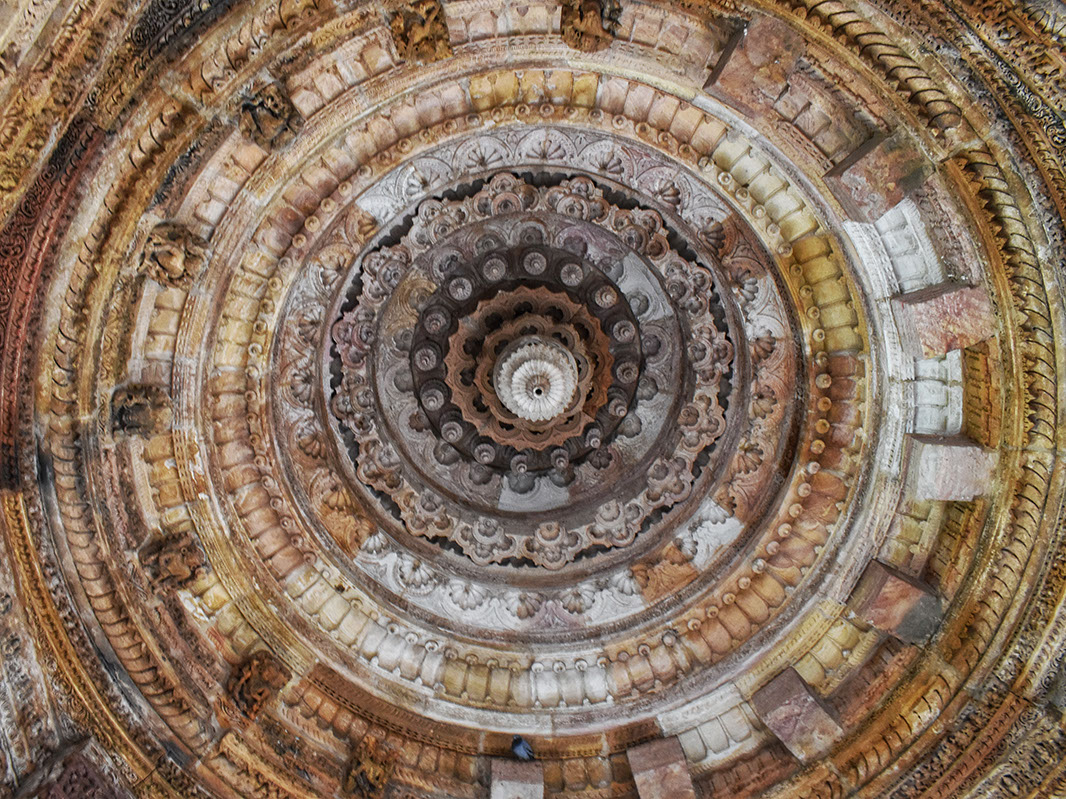
The exquisite ceiling of Rang Mandapa's central dome
The Mula Prasada (Main Temple)
In this historical structure, the Mula Prasada is the main temple dedicated to the Sun God. It is shaped like an extended rectangle with its longer side (north to south) running parallel to the entire site's axis. When viewed from the top, the structure appears to be an inverted lotus built on a platform. There are two parts to the main temple, Gudhamandapa in the east and Garbhagriha (the shrine) in the west.
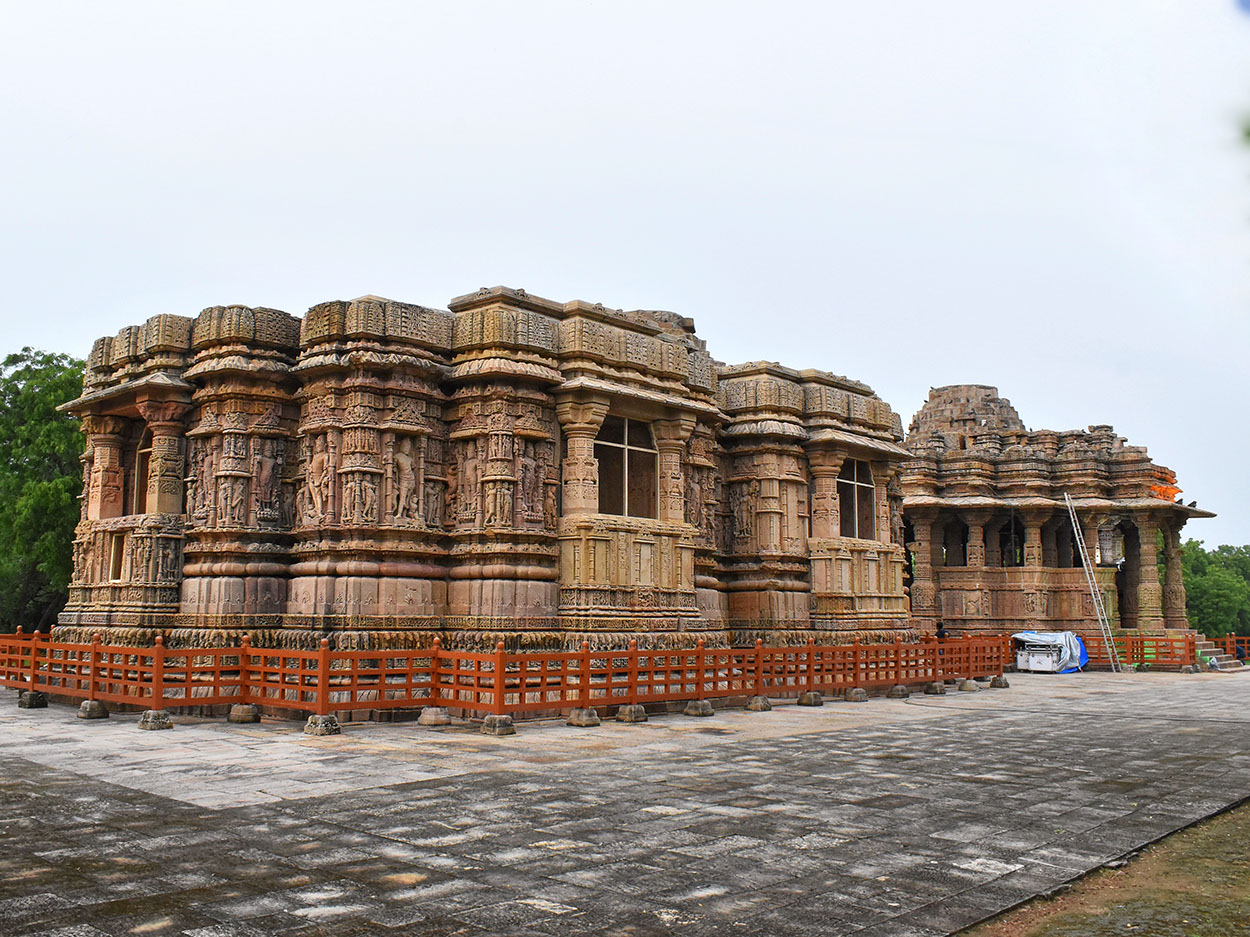
Southwest view of Modhera Sun Temple
The external elevation of the temple is divided into three sections.
- (1) The socle (Pitha): the layers are decorated with lotus petals, elephants, scenes of dancing, the process of childbirth and warring.
- (2) The temple wall (Mandovara)
- (2.1) The podium (Vedibandha): the upper side is decorated with caitya-arch motifs and the lower side with lotus petals with a band of triangular leaves.
- (2.2) The figural frieze (Jangha): they depict life-sized Hindu deities in high relief. All of them are framed. Each panel has multiple frames. There are a total 34 such panels on the four walls.
- (2.3)The eave-cornice (Varandika): it is a combination of decorative forms of socle and podium.
- (3) The superstructure
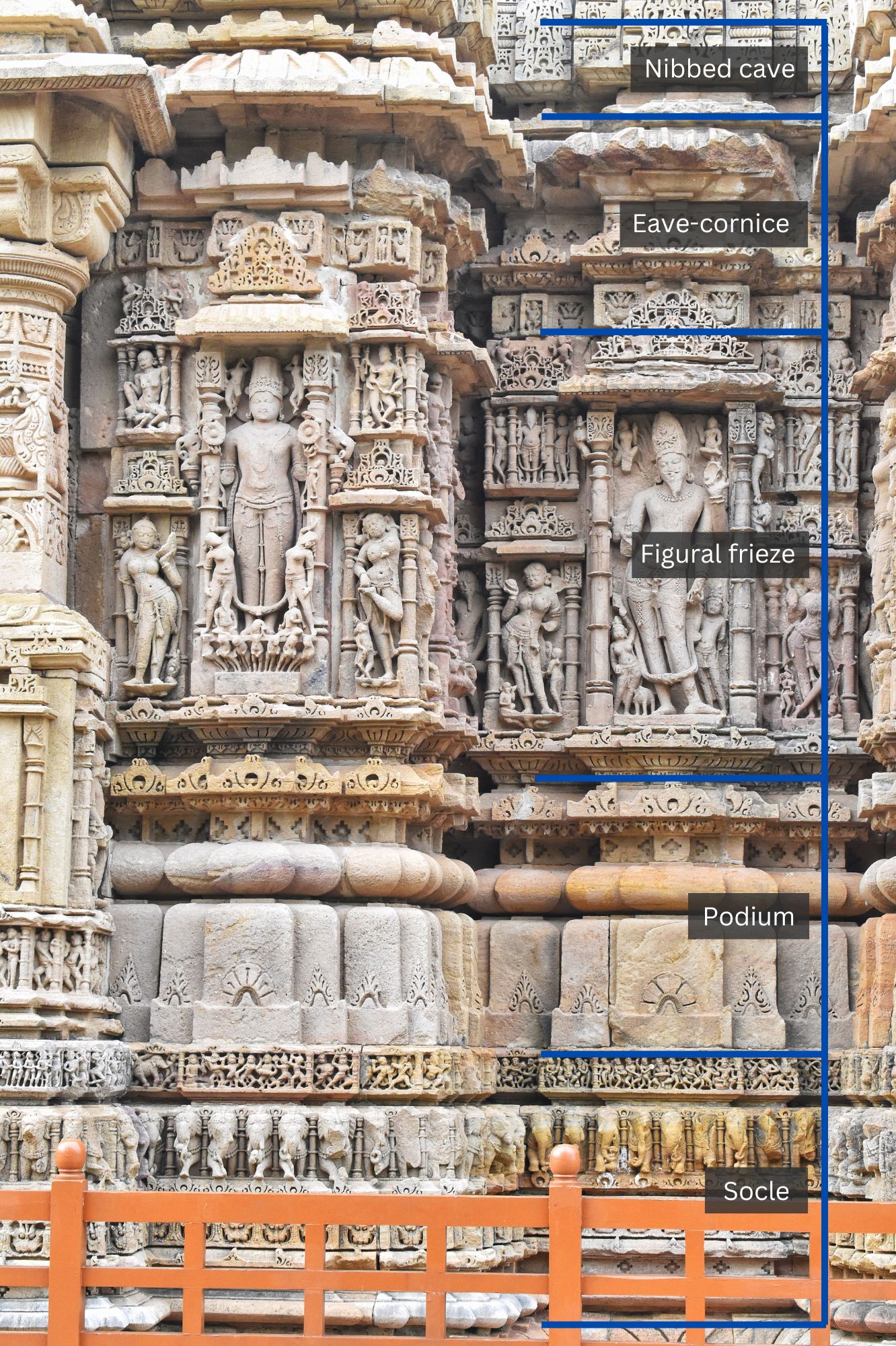
Architectural profile of the main temple wall with the Surya and Agni god statues
As per the "Vastu Shastra", the temple's outer walls are divided by recesses at its four corners. They include Bhadra, Karna, and Pratrita (the tria-anga) from the Vastu text. A porch connecting Sabha Mandapa to the temple entrance with windows in the north, south, and west are incorporated into the wall surfaces (rathas) between the terraced corners.
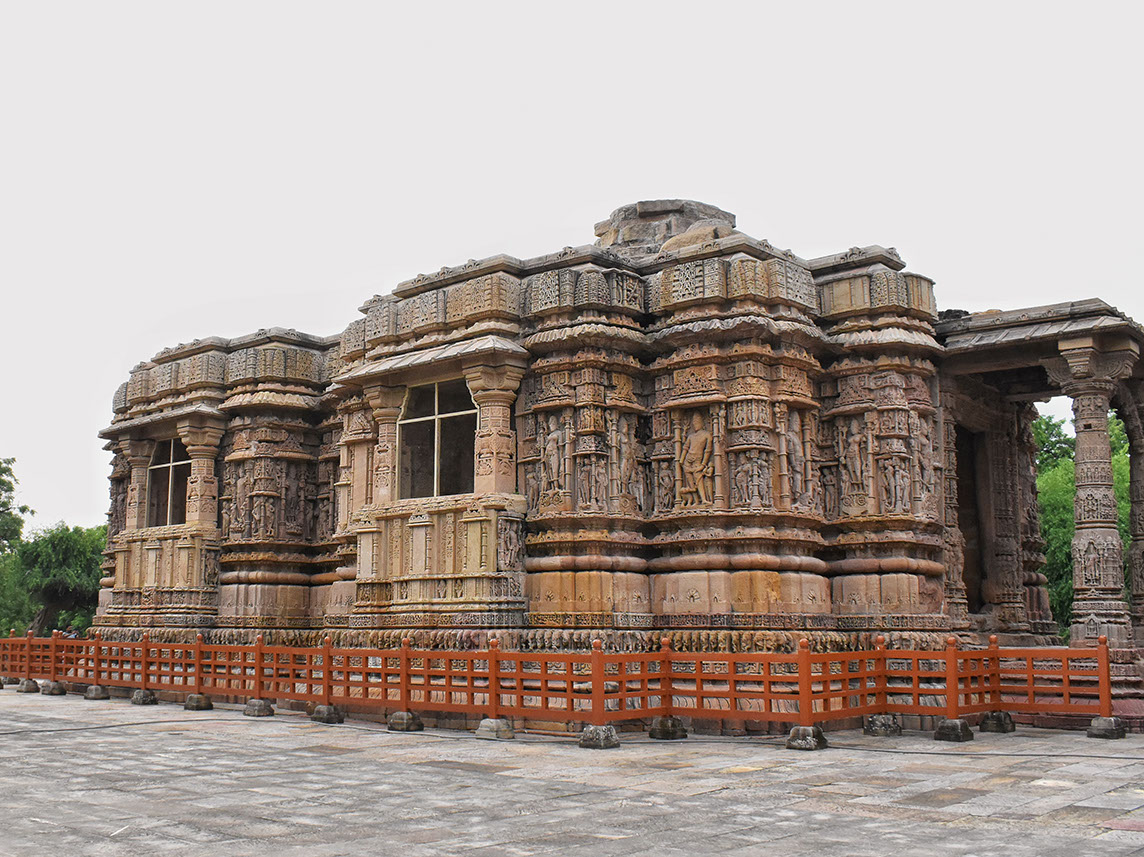
Southeast view of Modhera Surya Mandir
The Modhera Surya Mandir can be referred to as a historical icon for creative flamboyance. Not an inch of sandstone on this structure has been left untouched by the ingenous carvings. The creativity of the artists of those times is mindblowing, this is evident in the visionary work on the sandstones. Every design seems to be carefully thought out. For instance, an elephant motif (Gajathara) at the base of the temple consists only of the head with the front two legs and depicts them carrying the entire temple load on their shoulders. There are twelve names given to the Sun in Hindu mythology: Mitra, Ravi, Surya, Bhanu, Kha, Pusha, Hiranyagarbha, Marichin, Aditya, Savitr, Arka and Bhaskara. Hence, there are 12 statues resembling each name spread across all the walls. In addition to being unique, each statue depicts the Sun God riding a chariot with seven horses at the bottom. The seven horses represent the seven colors of a rainbow.
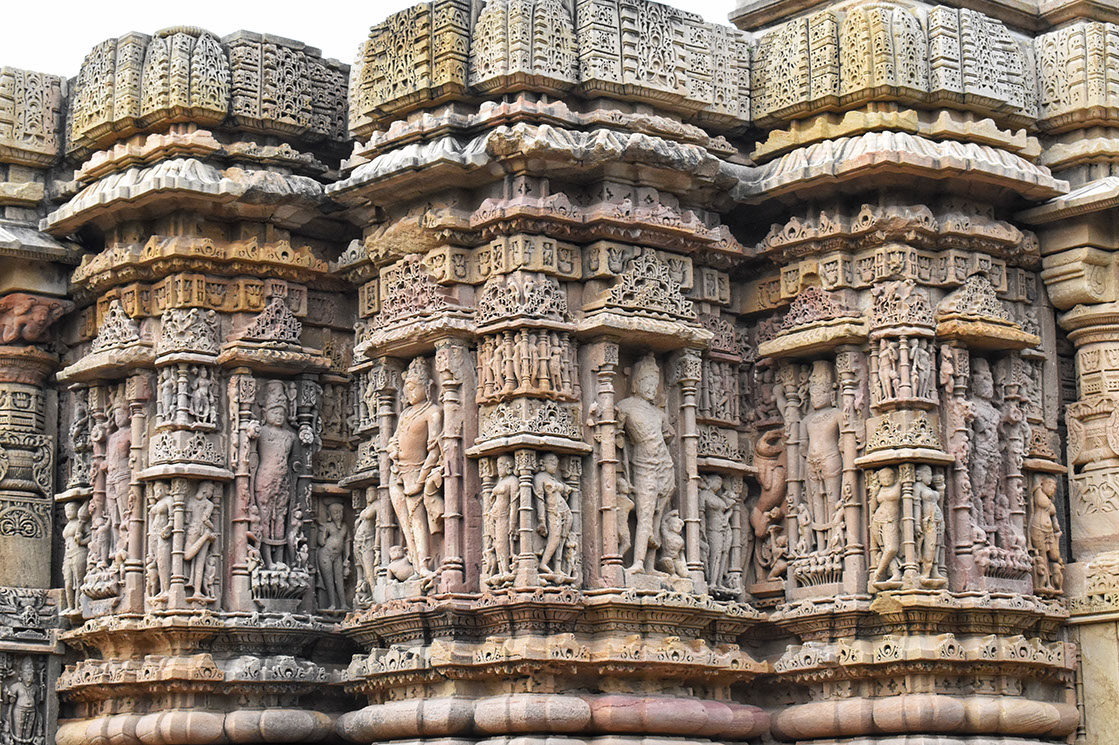
Two adjacent Lord Surya statues at alternate corners of the outer wall
From the outside it looks like each wall of the temple is choc-a-bloc with decorations, carvings and statues of various deities. However, they have followed a specific design method. It may not be immediately apparent to visitors until they inspect them closely. Each of the 10 statues of Goddess Parvati holds a weapon belonging to one of her 10 avatars. The statues are placed on platforms with lotus blossoms and conch shells beneath them. Tara, Sodasi, Bhuvaneshwari, Bhairavi, Chinnamasta, Dhumavati, Bagala, Matangi, Kamalatmika and Kali are the 10 avatars of Goddess Parvati.
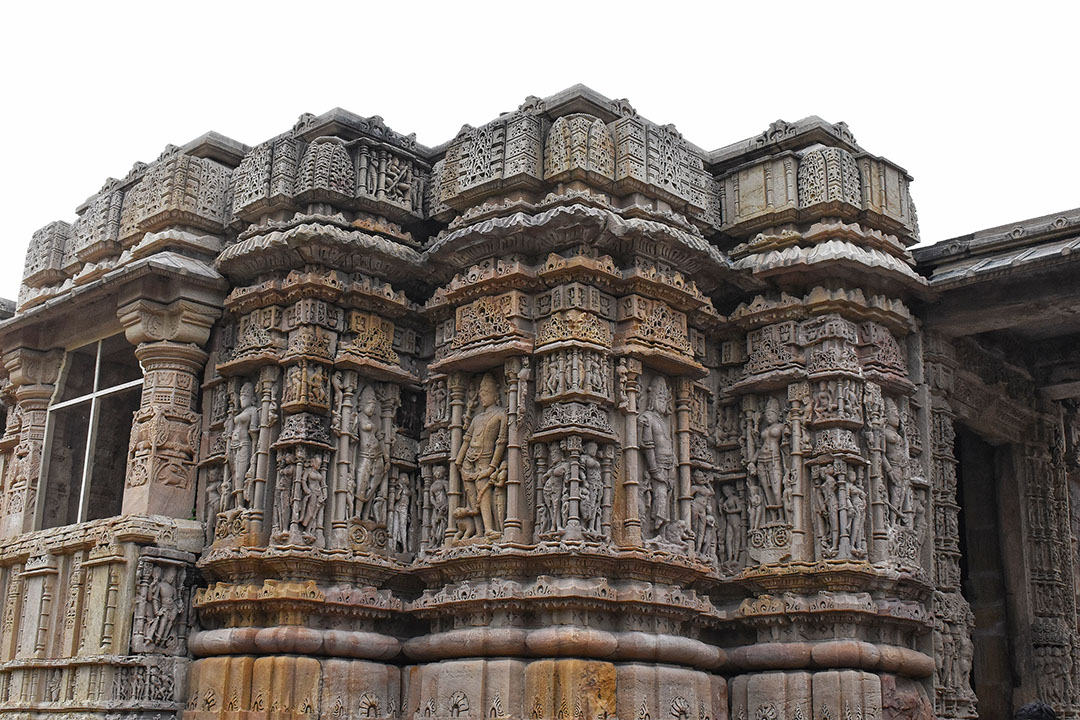
Two adjacent Goddess Parvati statues at alternate corners of the outer wall
This temple holds a wealth of knowledge on Hindu mythology. Each corner of these four walls tells a story that could keep one occupied for hours. Architects and designers knew that a Sun temple design would not be complete without Brahma, Vishnu, and Mahesh. They're carved into the west side of the temple's rear wall. Lokpals are guardian deities who sit in the eight corners of the temple according to Vastu Shastra. Here's the complete list:
- Kuber (the God of fortune) - North
- Yama (the God of justice and death) - South
- Indra (the God of heaven) - East
- Varuna (the God of ocean) - West
- Rudra or Ishana (the God Shiva) - Northeast
- Agni (the God of fire) - Southeast
- Vayu (the God of winds) - Northwest
- Ardhanarishwar (the Demigod of death and sorrow) - Southwest
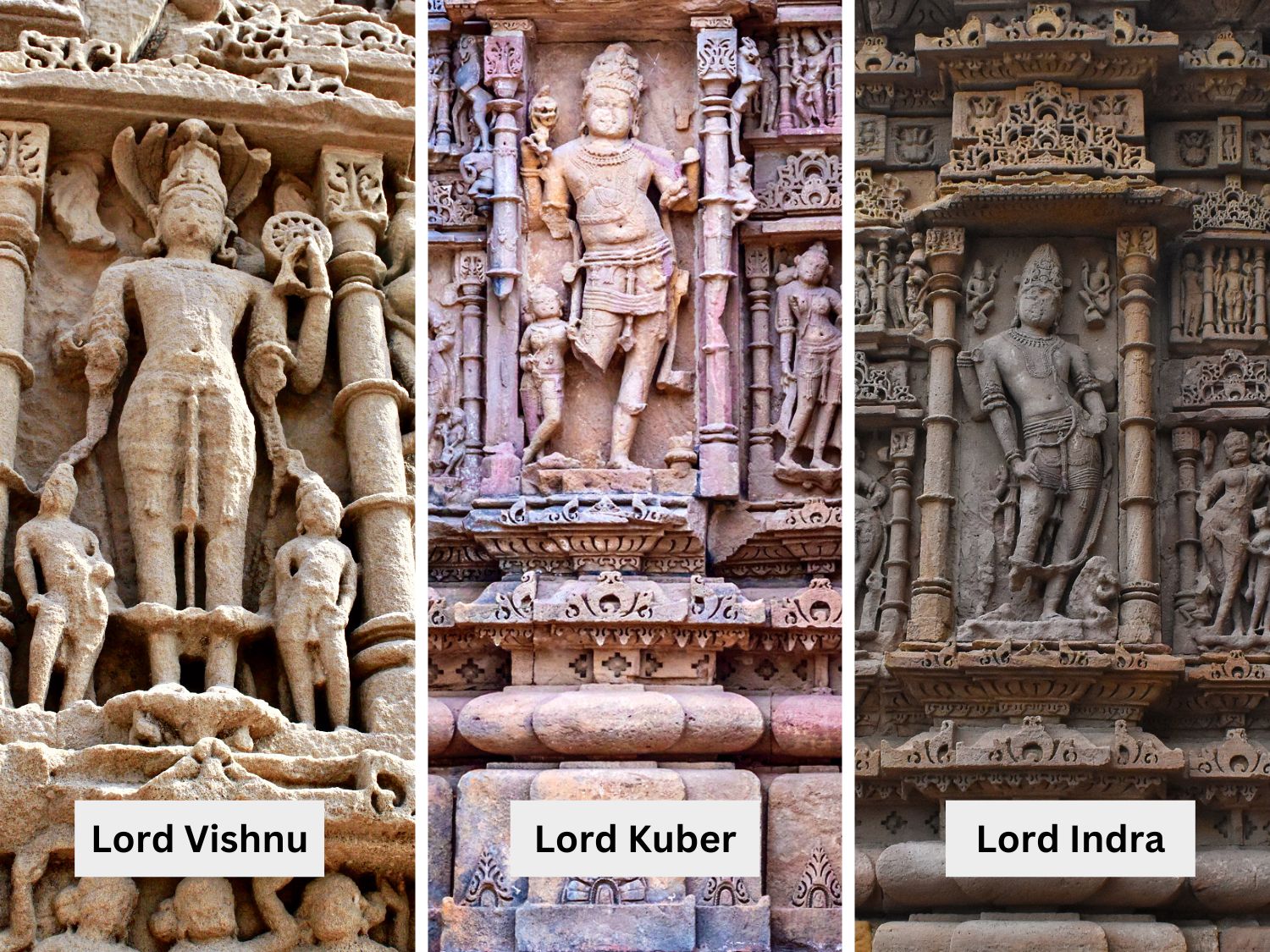
Carvings of various Hindu deities on the outer walls of Gudhamandapa
Celebration of Azadi Ka Amrit Mahotsav
It was both an honor and pure bliss for me to have been able to visit the Modhera Sun Temple during the celebrations of The Azadi Ka Amrit Mahotsav to commemorate the 75th Independence Day of India. Entry fees to the monument were waived for all and a tri-color light show was held in the evening at the Sabha Mandapa. This is why some of my photographs above display a hint of those hues which inevitably reflected in my captures. Take a look at a few more photos to appreciate how beautiful this heritage monument looks when draped in tiranga.
During routine days, the entry fee for Indian citizens is INR 25 and for foreign citizens it is INR 300. There is no charge for children under 5 years old. The opening hours are daily from 7 am to 6 pm.
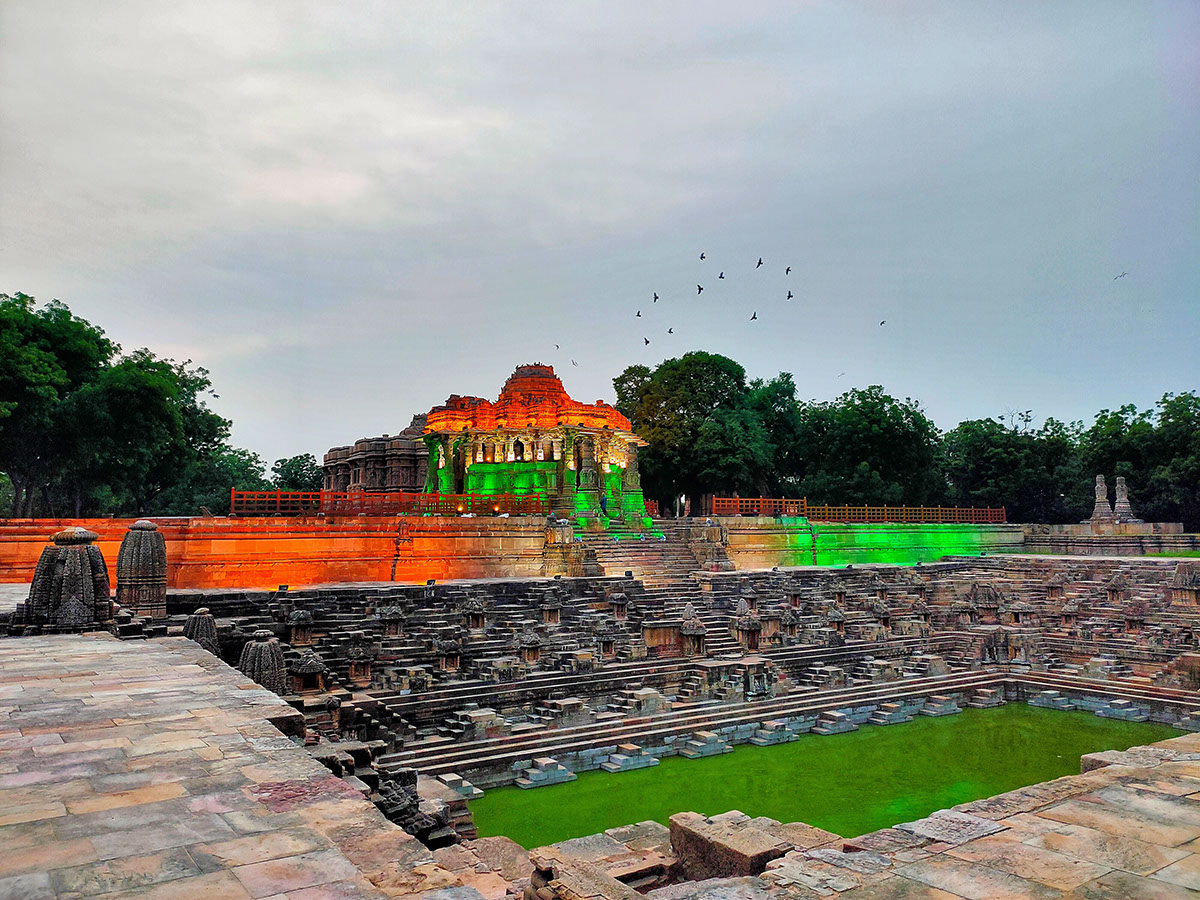
The Sabha Mandapa was draped in tri-color during the 75th Independence Day celebrations
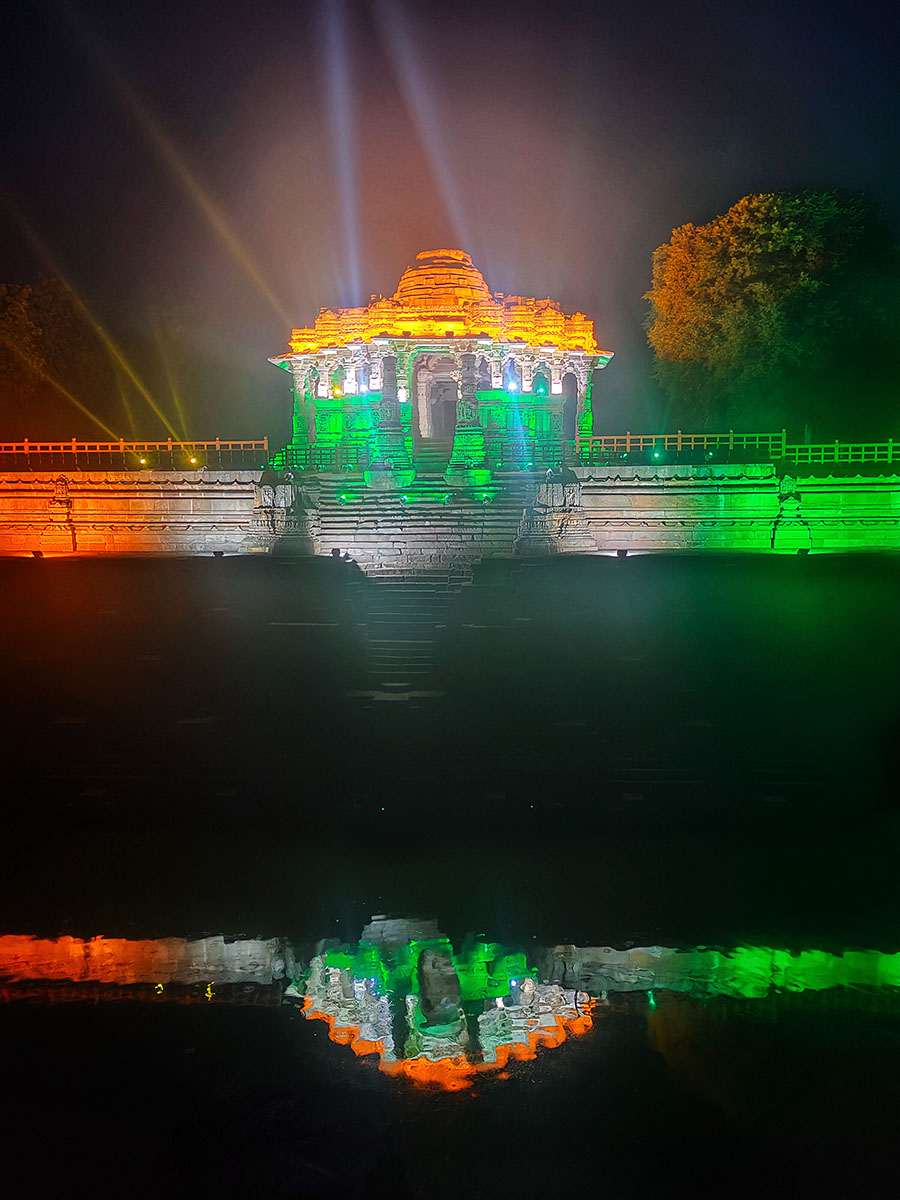
The illumination of the tri-color by laser and its reflection in Surya Kund
A glorious experience
Modhera Sun Temple will soon be a 1000-year-old monument. Each stone tells a story about its glorious past. It completely captivated me. Every story has a climax, and Modhera was no exception. The pomp and affluence of the temple was spread a few thousand miles away. In 1025, Allaudin Khilji, ruler of the Turkish dynasty, attacked Gujarat and destroyed the temple. According to legend, he looted the golden idol of the Sun God from Garbhagrih. It was rebuilt, but couldn't survive after frequent attacks by Mahmud Ghazni. For centuries, ruins of this grandeur lay buried until Colonel Monier-Williams discovered the site in 1809 and called it "One of the finest specimens of ancient Hindu architecture I ever saw."
Frequently Asked Questions:
What's the best way to get to Modhera Sun Temple?
The Modhera Sun Temple is located in the small town of Modhera, 100 km from Ahmedabad and 25 km from Mehsana. You can take a taxi or a GSRTC bus from Ahmedabad. Ahmedabad has low frequencies, but Mehsana has plenty. Ahmedabad and Mehsana are connected by rail.
What makes Modhera Sun Temple so famous?
The Modhera Sun Temple is a Hindu temple dedicated to the deity Surya, the Sun God. It is famous for its unique architecture that revolves around the solar system. The temple is also known for its extensive decorative carvings, which depict scenes from Hindu mythology.
What are the characteristics of the Sun Temple Modhera?
As the Sun Temple Modhera is designed such a way the first rays of the sun fall on the main shrine during the Equinoxes. Due to its location at the tropic of cancer, it doesn't cast a shadow during the Solar Solstice.
How old is Modhera Sun Temple?
Modhera Sun Temple was built in 1024. Soon it'll be 1,000 years old.
How many sun temples are there in India?
There are many sun temples in India, but three are famous. Other than Modhera, there are two others in Konark (Odissa) and Anantnag (Kashmir).
Who had attacked the Sun Temple of Modhera?
The Modhera Sun Temple was attacked and looted by Allaudin Khilji in 1025. Historians believe that he was motivated by the temple's wealth. The temple was plundered of its jewels and statues.
Disclaimer: This blog may contain affiliate links. At no extra cost to you, we may get a small commission if you buy anything. All products and services we endorse have been personally used or come highly recommended to us. These incomes allow us to keep the community supported and ad-free.


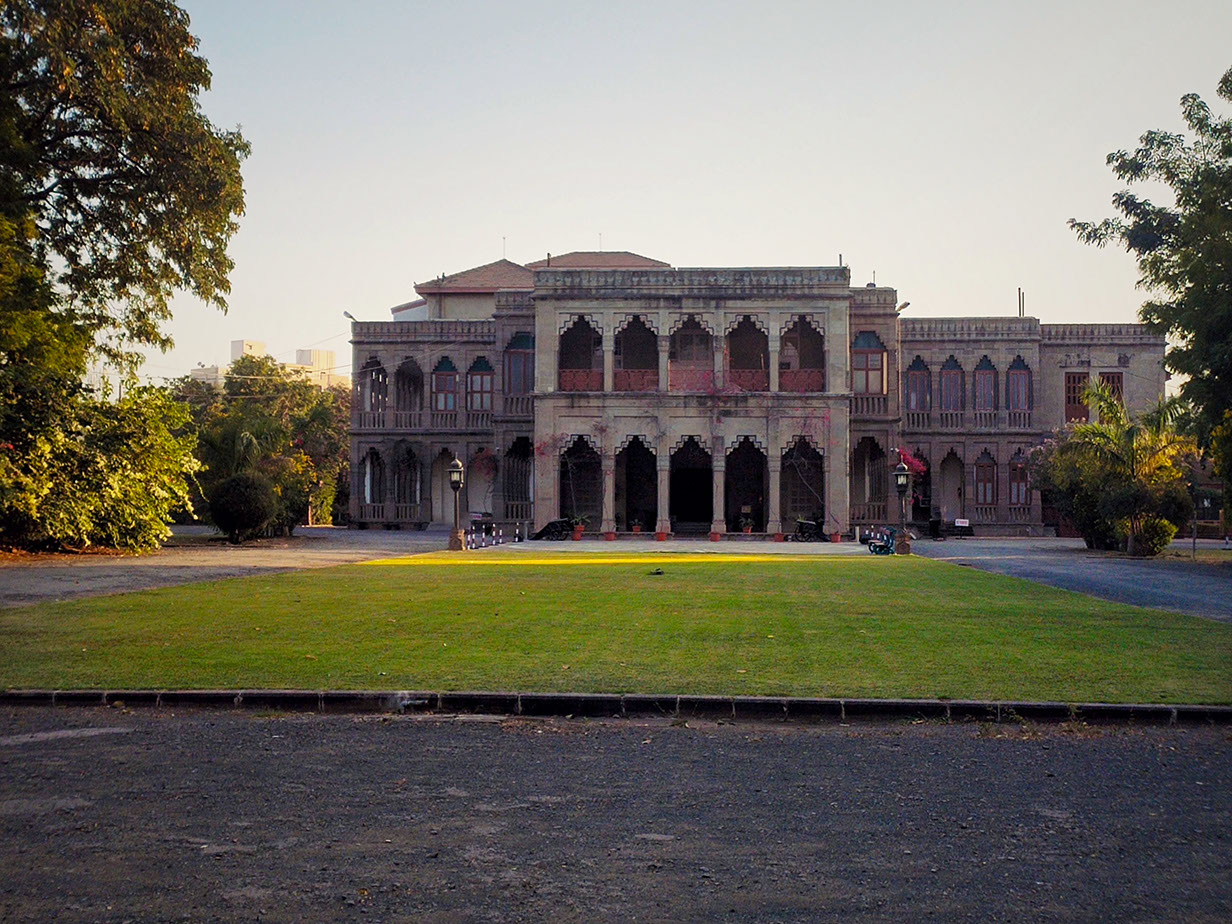
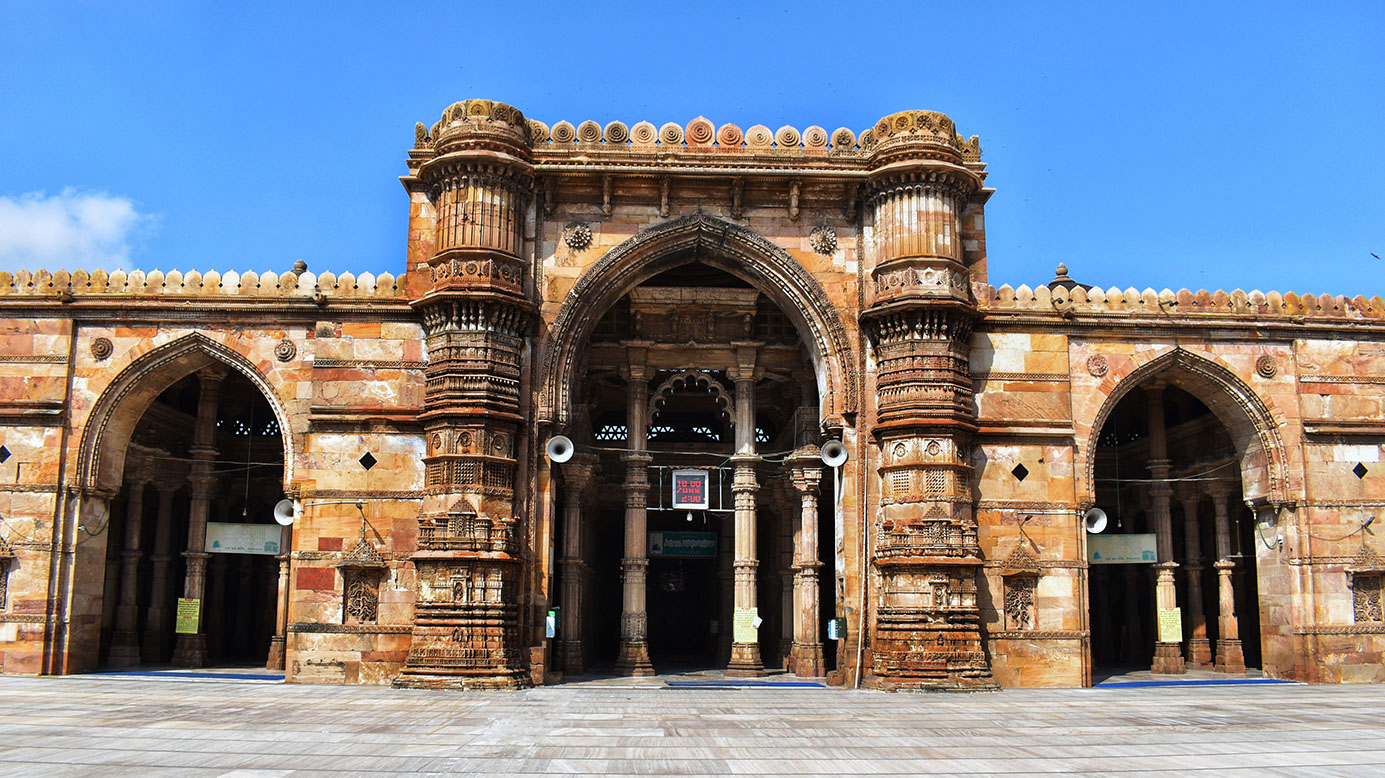
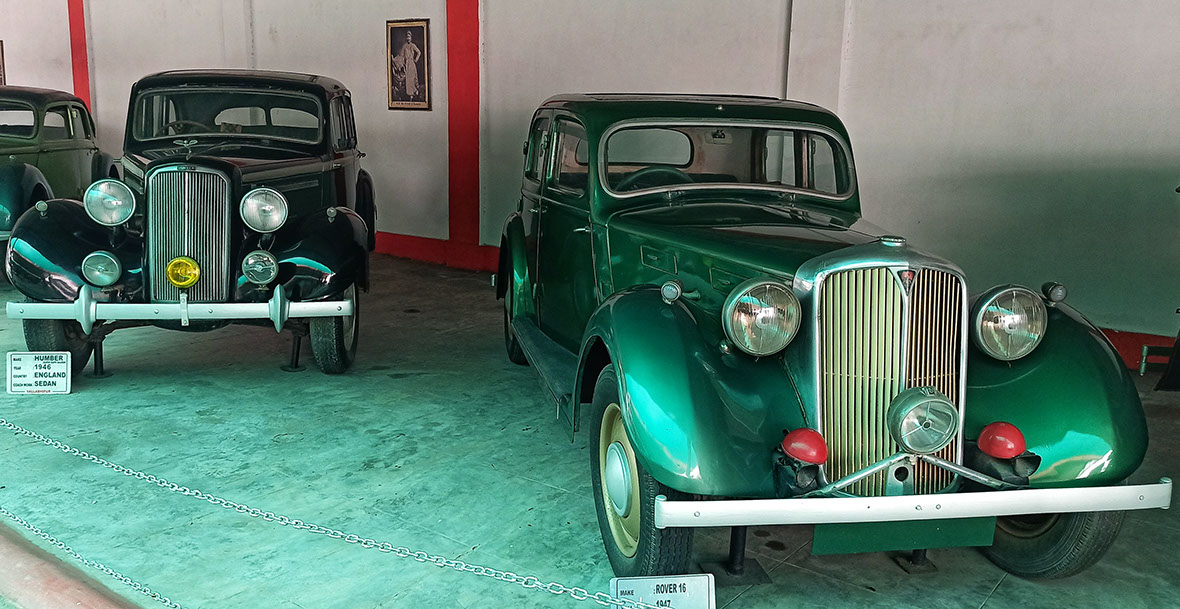

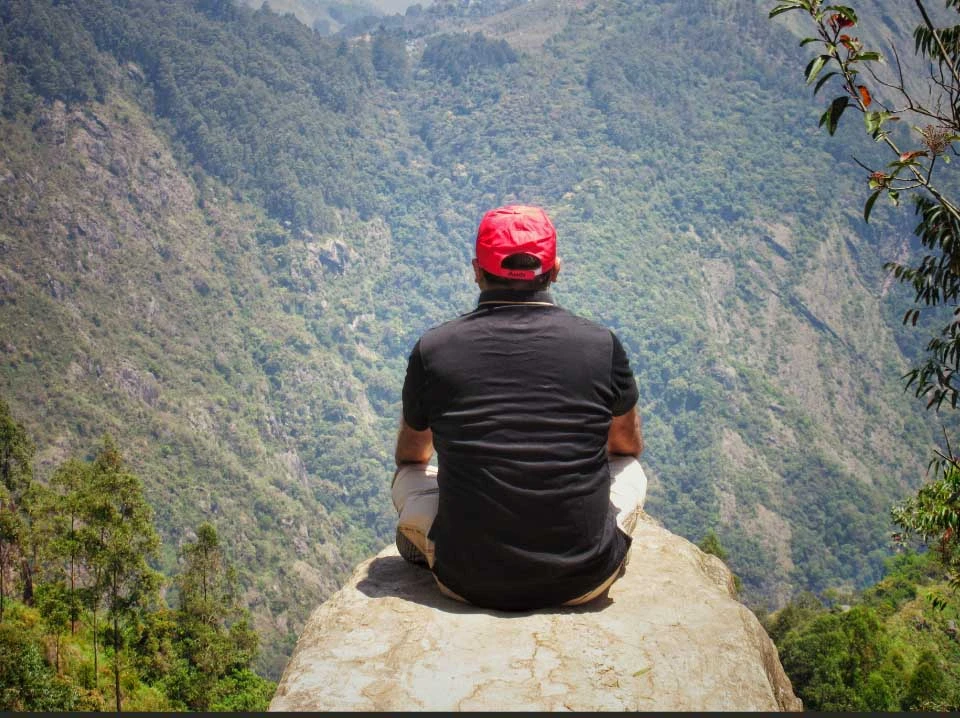
Name
Email
Comment